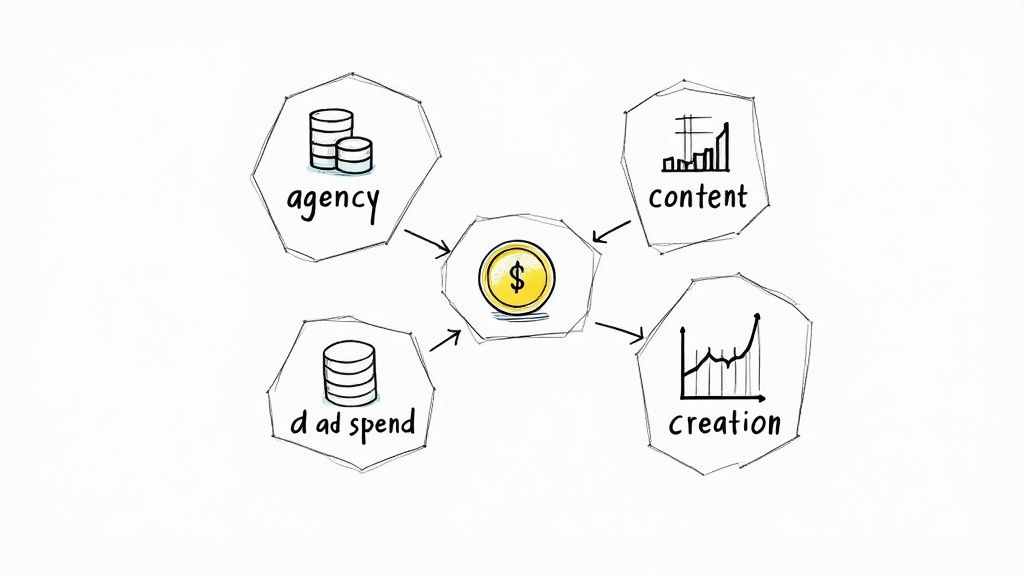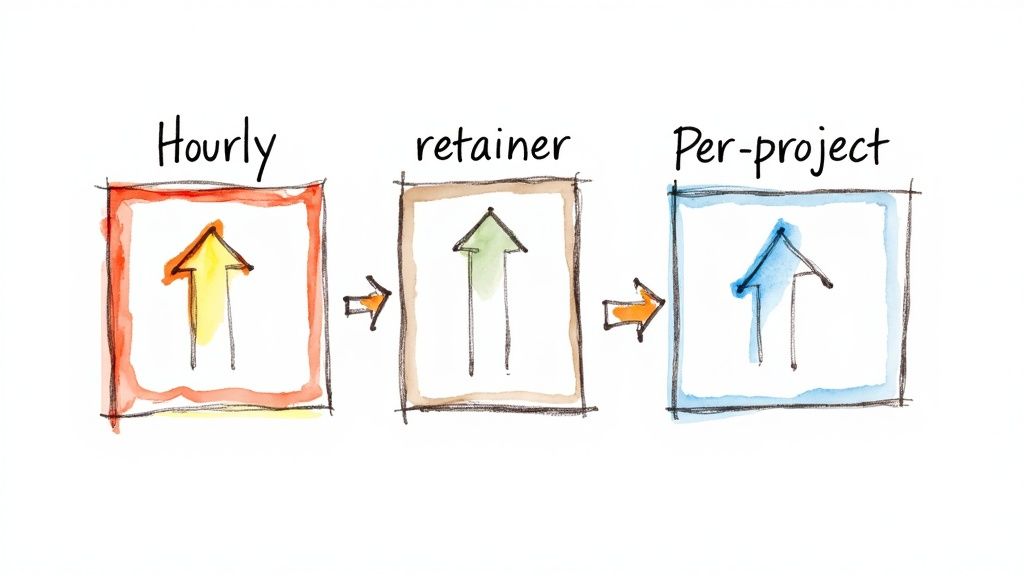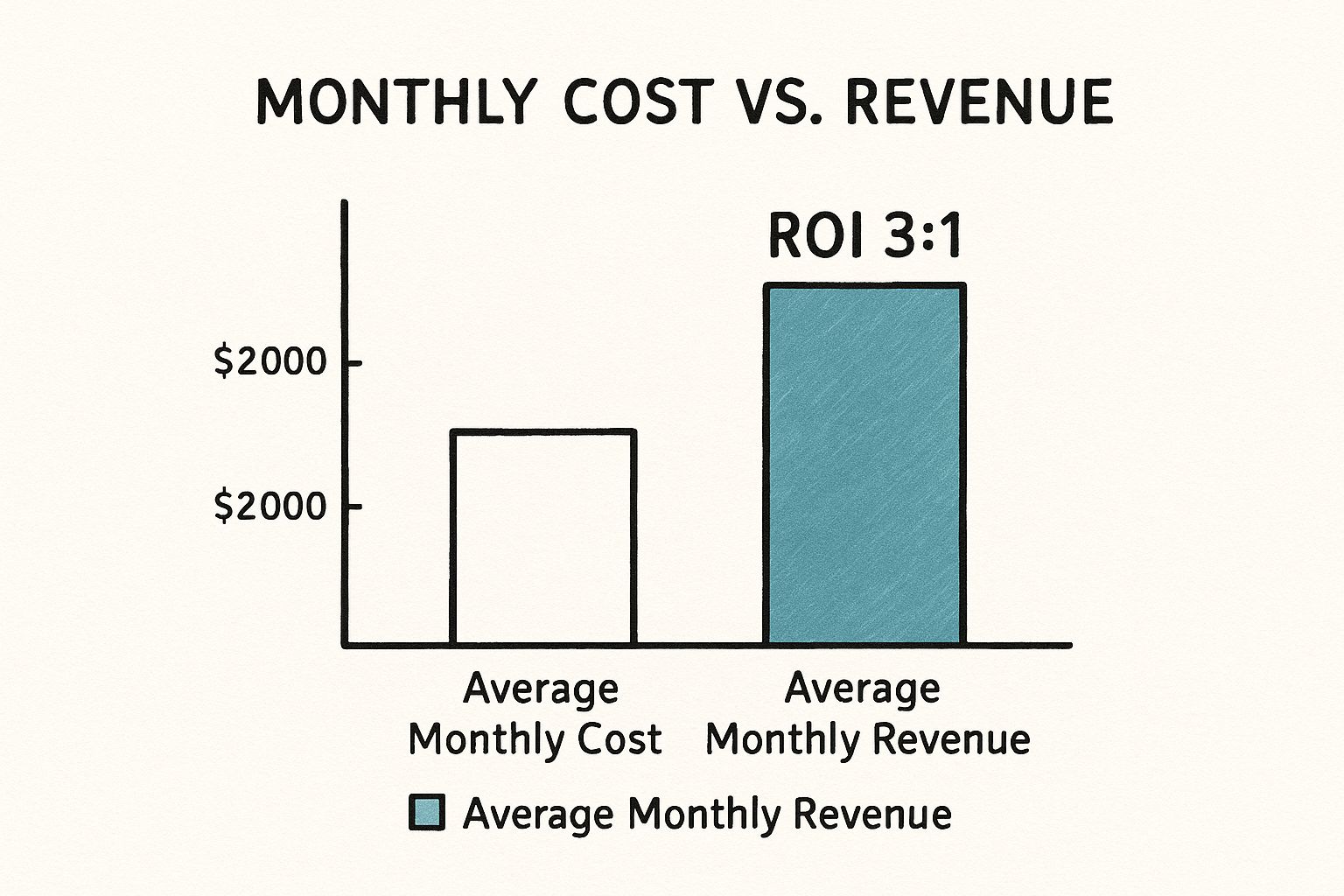So, what’s the bottom line? Let’s get right to it. Social media management costs typically run anywhere from $500 to $5,000 per month.
Where you fall on that spectrum really comes down to what you need. Think of it less like a fixed price and more like building a custom package. The final number is a direct reflection of the work involved.
What to Expect for Your Investment
When you’re trying to understand social media management costs, it’s helpful to think about what you’re actually paying for. The price tag isn’t just pulled out of thin air; it represents the expertise, time, and resources needed to make your brand stand out online.
Building a social media presence is a lot like building a house. A simple, functional blueprint is going to cost less than a grand architectural design with marble countertops and a home theater. Both get you a house, but the scope and results are worlds apart.
This investment covers a whole lot more than just scheduling a few posts. It’s the strategic brainpower behind a campaign, the creative energy that goes into making great content, and the analytical deep-dive to see what’s actually working.
As a rule of thumb, most companies set aside 5% to 25% of their total marketing budget for social media. That’s a serious chunk, which shows just how critical it is for driving real business results.
A Quick Look at Service Tiers
To make this more concrete, let’s look at what different budgets typically get you. This will help you set realistic expectations for the kind of service you can expect at various price points.
- Basic Management (Lower End): This is your entry-level package. It usually covers posting content on one or two social channels, keeping an eye on comments, and a simple monthly report. It’s a great starting point for new businesses.
- Comprehensive Management (Mid-to-High End): Here, you’re getting the full treatment. This includes everything in the basic tier plus a custom strategy, management across multiple platforms, more advanced content like video, and proactive community building.
At the end of the day, what you pay for social media management is tied directly to the scope of work. A small shop needing a straightforward presence will land on the lower end, while a larger company wanting an all-in strategy will be closer to the top. You can get a better feel for how these prices are determined by checking out some industry pricing insights.
Estimated Monthly Social Media Management Costs
Here’s a quick table to give you a clearer idea of what you can expect to pay and what you get for your money.
| Service Level | Typical Monthly Cost | Best For | Common Services Included |
|---|---|---|---|
| Starter / Basic | $500 – $1,500 | Small Businesses & Startups | Content scheduling, basic reporting, light community monitoring |
| Growth / Standard | $1,500 – $3,500 | Mid-Sized Businesses | Full content strategy, multi-platform management, community engagement |
| Enterprise / Premium | $3,500 – $5,000+ | Large Companies & Corporations | Advanced analytics, paid ad management, video production, influencer outreach |
This breakdown helps visualize how services scale with cost. The more you invest, the more hands-on and strategic the approach becomes, moving from simple maintenance to a powerful growth engine for your business.
Understanding the Three Pricing Models
When you start looking into social media management, you’ll quickly see that the costs are usually structured in one of three ways. Getting to know these pricing models is key, because each one is built for different business needs and goals. It’s a bit like choosing a mobile phone plan—what works for someone who just texts and makes a few calls is a terrible fit for someone streaming movies 24/7.

The price you’re quoted will almost always fall into one of these buckets. Let’s break down what they are so you can figure out what’s right for you.
The Hourly Rate Model
Think of this as your “pay-as-you-go” option. You’re billed for the specific hours someone works on your account, with rates typically running from $50 to over $150 per hour, depending on their experience level. This model is all about flexibility and is a fantastic fit for businesses that don’t need someone on the job full-time.
For instance, you might bring someone on for a few hours to do a quick audit of your accounts, set up new profiles the right way, or get some expert feedback on a campaign you’re planning. It’s a low-commitment way to tap into professional expertise for specific, short-term tasks without being locked into a contract.
The Monthly Retainer Model
The monthly retainer is the “unlimited data plan” of the social media world. You pay a set fee every month for an agreed-upon list of ongoing services. This is easily the most popular model because it creates stability and predictability for everyone involved.
A monthly retainer means you have a dedicated partner consistently working to grow your brand’s presence. This model is designed for long-term results, paving the way for deep strategy, ongoing content creation, and real-time community engagement.
With a retainer, the relationship shifts from just a task-doer to a true strategic partner who is invested in your success. It’s the perfect choice for any business that’s serious about building a strong, lasting presence online. These retainers can range anywhere from $500 to $5,000+ a month, directly tied to how much work is involved.
The Project-Based Fee Model
Lastly, there’s the project-based fee, which is like buying a new phone outright. You agree on a single, fixed price for a project that has a clear start and finish. The big difference from hourly work is that the price is connected to the final deliverable, not the time it takes to get there.
This model is a great fit for one-off campaigns, such as:
- A product launch: Getting all the social media content and buzz ready to introduce something new.
- An event promotion: Handling the social media hype before, during, and after a big conference or webinar.
- A content package: Creating a batch of 30 professionally designed graphics and captions for you to post later.
Project fees give you total cost certainty, which is a budgeter’s dream. You know exactly what you’re paying and exactly what you’re getting, making it a predictable way to handle your social media management cost for a specific objective.
The Key Factors That Shape Your Final Price

If you’ve ever shopped around for social media management, you’ve probably noticed the prices can be all over the map. One quote might be for a few hundred dollars, while the next is well into the thousands. This isn’t random; the final social media management cost is a sum of its parts.
Think of it like building a custom car. The basic chassis has a starting price, but every upgrade—a more powerful engine, a premium sound system, custom paint—adds to the final sticker price. Each service you add to your social media plan is another “upgrade” that requires more time, specific skills, and dedicated resources.
Let’s pop the hood and look at the individual components that determine how much you’ll actually spend. When you understand these, you can see exactly where your money is going.
Scope of Services
The single biggest factor driving the cost is, quite simply, the amount of work you need done. A bare-bones plan might just cover scheduling content you’ve already created. On the other hand, a comprehensive package could involve an entire team handling everything from high-level strategy to day-to-day crisis management.
Here are the core services that directly move the price needle:
- Number of Platforms: Managing a single Instagram account is one thing. Juggling content and engaging with communities across Instagram, Facebook, TikTok, and LinkedIn is a whole different ball game. Each platform has its own rules, audience, and content style, which multiplies the workload.
- Posting Frequency: How often do you want to show up? A schedule with three posts a week is far less intensive than a plan with daily posts, multiple Stories, and live video sessions.
- Community Engagement: Is your manager just posting and walking away? Or are they in the trenches, actively replying to comments, answering DMs, and sparking conversations? Proactive engagement takes a lot of time but is absolutely essential for building a real community.
Why does this matter? It’s all about connecting with people. A global survey found that 81% of marketers view increased brand exposure as the #1 benefit of social media. It’s followed closely by driving more website traffic (73%) and generating new leads (65%). These are the results you get when you invest in the right services. You can see the full breakdown of how businesses benefit from social media marketing.
Content Creation Complexity
Not all content is created equal. The type of posts, videos, and graphics you need will have a massive impact on your social media management cost. It’s the difference between a quick text update and a polished, professionally shot video.
Here’s a simple breakdown of how content complexity scales up:
- Simple Graphics & Curated Content: This is your most budget-friendly starting point. It usually involves creating basic branded images from templates or sharing interesting articles and posts from others in your industry.
- Custom Photography & Advanced Graphics: If your plan calls for original photoshoots or detailed infographics, the price goes up. This covers the cost of professional photographers, designers, and their equipment.
- Short-Form Video (Reels & TikToks): Making great short-form video is a true skill. It requires planning, filming, sharp editing, and knowing which trends to jump on. It’s a specialized service that commands a higher rate.
- High-Production Video: This is the top tier. Think long-form YouTube videos, professionally produced interviews, or slick animated explainers. This level of quality requires a team of specialists and the budget to match.
At the end of the day, the price tag directly reflects the resources needed to get the job done. By understanding these key factors, you can make smarter decisions and build a plan that truly fits your goals and your budget.
So, you’ve got a handle on what goes into social media management costs. The next big question is: who’s actually going to do the work? This isn’t about finding one “best” answer; it’s about picking the right partner for your specific business needs. You’re looking at three main paths: building an in-house team, hiring a marketing agency, or bringing on a freelancer.
Each option comes with its own unique mix of cost, control, and expertise. I like to think of it like this: an in-house team is like building a custom kitchen. It’s designed exactly for you and seamlessly integrated into your home (your business), but it comes with the significant upfront investment and ongoing costs of construction, appliances, and maintenance.
Visual platforms often require more upfront planning and consistency. For brands investing in evergreen visuals, using Pinterest post scheduling helps maintain steady visibility without increasing manual workload.
Comparing Your Management Options
To make this decision easier, let’s break down how each option stacks up against the others. Think about what matters most to you right now—is it budget, specialized skills, or having complete control?
This table lays it all out, comparing the core factors you need to consider.
| Factor | In-House Team | Marketing Agency | Freelancer |
|---|---|---|---|
| Cost | Highest (salaries, benefits, tools) | Moderate to High (monthly retainer) | Lowest (hourly or project-based) |
| Expertise | Deep company knowledge | Broad, diverse team of specialists | Specialized in a specific niche |
| Scalability | Slow and resource-intensive | High (can scale services up or down) | Moderate (depends on individual capacity) |
| Control | Full control over brand and strategy | Less direct, more collaborative | High control on a per-project basis |
As you can see, there are clear trade-offs. The highest cost often brings the most control, while the lowest cost might require more hands-on management from you. Let’s dig a little deeper into what each of these really means for your business.
The Full-Service Agency Approach
Hiring a marketing agency is kind of like getting an all-access pass to a professional toolkit. Instantly, you have a whole crew of experts at your disposal—strategists, copywriters, designers, and ad specialists. This is a brilliant move for businesses that need a wide range of skills but don’t want the long-term headache and expense of hiring for each role individually.
Agencies have seen it all. They’ve worked with tons of different clients, which means they come to the table with battle-tested strategies and a deep well of industry knowledge. The flip side? Their attention is split across their entire client list. You won’t get the same undivided focus as you would from a dedicated employee, and their monthly retainers reflect the cost of keeping that full team on standby.
The Specialized Freelancer Option
A freelancer is your go-to specialist, the expert you hire for a specific job. For small businesses or anyone needing a very particular skill—like a killer TikTok video editor or a LinkedIn ghostwriter—this is often the most flexible and budget-friendly choice. You get top-tier talent without the overhead of a full-time salary or a hefty agency fee.
The biggest win here is agility. You can bring a freelancer in for a short-term project or scale their hours up and down as your needs change. The challenge, however, is that if you hire multiple freelancers for different things, you become the project manager. To keep everything from falling into chaos, using good social media collaboration tools is a lifesaver for organizing tasks and keeping everyone on the same page.
The Bottom Line: Your choice boils down to your budget, your goals, and how much you want to be in the driver’s seat. No single option is perfect for everyone; the best fit is the one that matches where your business is today and where you want it to go.
And don’t forget why this investment matters. Effective social media management isn’t just a cost—it’s a powerful engine for growth.

The data speaks for itself. On average, for every $1 invested in social media management, businesses can see a return of $3 in revenue. That’s a clear sign that when done right, this is an investment that pays for itself.
Budgeting for Paid Social Advertising

One of the biggest questions I see pop up is about paid ads. People often mix up the management fee with the actual advertising budget, but it’s really important to know they are two totally separate costs. They work hand-in-hand, but you’re paying for very different things.
Here’s an analogy I like to use: the management fee is what you pay the chef. It covers their experience, their creative ideas, and the time they spend putting together the perfect recipe. Your ad spend is the money you give the chef to go buy the fresh, high-quality ingredients. You can’t have a fantastic meal without both.
So, your management fee pays for the strategy and the execution—all the campaign planning, content creation, audience research, and performance tracking. The ad spend is the money that goes directly to the social media platforms themselves, like Meta, LinkedIn, or TikTok, to run your ads.
Why Ad Spend Is a Separate Cost
Your ad budget is what gets your content seen by a much larger audience than just your followers. Without it, you’re relying purely on organic reach, which can be pretty limited. Paid ads are the fuel that powers real growth, helping you find new customers, get more website traffic, and bring in leads on a much bigger scale.
Your management fee pays for the expertise to build and aim the “growth cannon.” Your ad spend is the ammunition you load into it to hit your targets. One is ineffective without the other.
Understanding this difference is key to creating a social media budget that actually works. Any proposal you get from an agency or freelancer should spell this out clearly, separating the management costs from the recommended ad spend. This transparency shows you exactly where your money is going.
How Much Should You Budget for Ads?
Globally, spending on social media advertising is on track to reach a staggering $276.7 billion in 2025. With an average ad conversion rate of 9.21%, it’s obvious why businesses everywhere are investing heavily in paid social to grow.
So, what’s the right number for you? It really depends on your industry, your specific goals, and how quickly you want to see results. A good starting point for many businesses is to match your ad spend to your management fee (a 1:1 ratio), but you can always adjust this.
For a clearer picture of how this fits into your company’s overall finances, check out this comprehensive guide to budgeting for small business success. A solid budget is the foundation of any good social media marketing plan template.
Getting the Most from Your Investment
Figuring out what social media management costs is one thing, but making sure that money actually brings in real results? That’s the real game. To get the most from your budget, you have to start with incredibly clear goals.
Before you even think about hiring someone, nail down what success actually looks like for you. Is it generating more leads? Getting more people to interact with your posts? Driving a flood of new visitors to your website?
When you know your destination, you can plan the most direct route. It stops you from spreading your budget too thin across every social media platform under the sun. Instead, you can zero in on the one or two channels where your ideal customers actually hang out. Always remember: quality beats quantity, every single time.
Here’s a pro tip I always share: get more mileage out of your best content by repurposing it. That killer blog post you wrote? It can become a short video, a set of eye-catching graphics, or even a compelling Twitter thread. This is how you stretch your content budget further.
Making Every Dollar Count
To really maximize your investment, you need to focus on tactics that directly fuel your brand’s growth. For example, learning how to start building your online presence through social media marketing is a game-changer for your ROI because it aligns your spending with what’s already proven to work.
Another absolute must is obsessive tracking. Don’t just throw content out there and hope for the best. You have to dig into the data and analyze how it’s performing. This isn’t optional.
Solid social media analytics and reporting is the only way to know what’s resonating with your audience and what’s falling flat. It lets you confidently double down on what works and cut the dead weight from your strategy.
By setting clear goals, focusing your efforts where they matter most, and constantly measuring your results, you’ll see social media management for what it truly is—not an expense, but a powerful, profitable investment in your brand’s future.
Frequently Asked Questions
It’s completely normal to have a few questions when you’re trying to figure out social media management costs. Let’s tackle some of the most common ones so you can move forward with confidence.
How Much Should a Small Business Pay for Social Media Management?
For most small businesses, a realistic budget for social media management lands somewhere between $500 and $2,000 per month.
At the lower end of that spectrum, you’re generally covering the essentials—think consistent posting and monitoring on one or two key platforms. As you move closer to the $2,000 mark, you’re investing in a more robust strategy that includes things like custom content creation and active community engagement. It’s all about what you want to achieve; a simple, steady presence costs less than a full-blown growth campaign.
What Is Included in a Basic Social Media Package?
A basic or starter package is your foundation. It’s designed to get your brand online and keep the lights on, ensuring your profiles look professional and stay active.
Typically, you can expect these core services:
- Content Scheduling: A handful of posts (usually 3-5) scheduled each week on one or two of your main social channels.
- Basic Reporting: A monthly look at essential numbers, like how many new followers you’ve gained and how people are engaging with your posts.
- Community Monitoring: Someone will keep an eye on comments and messages, but deep, time-consuming conversations might be an add-on.
This kind of package gets the job done without the price tag of a comprehensive, multi-channel campaign.
Are Long-Term Contracts Better Than Monthly Agreements?
This really depends on your business’s current situation and how much flexibility you need. Monthly agreements are fantastic for businesses just starting out, as they let you test the waters without a big commitment. You can easily adjust your plan or even change providers if needed.
On the other hand, long-term contracts (think 6-12 months) often come with a better monthly rate. More importantly, they give your social media pro the time to build real momentum. Great social media results don’t happen overnight, and a longer partnership allows for a strategy to unfold and deliver compounding returns.
How Do I Measure the ROI of My Social Media Management?
Measuring your return on investment is impossible without first defining what a “return” means to you. Before you spend a dime, set clear, measurable goals. Are you trying to get more website traffic, generate leads through a contact form, or drive direct sales?
Once you know your target, you can use built-in social media analytics and tools like Google Analytics to connect the dots between your social activity and those business outcomes. Keep a close eye on metrics like conversion rates, cost per lead, and the customer lifetime value of people who come from your social channels.
Ready to take control of your social media without breaking the bank? Postiz offers a powerful, open-source platform to schedule posts, create stunning visuals, and analyze your performance all in one place. Start streamlining your strategy today with Postiz.





